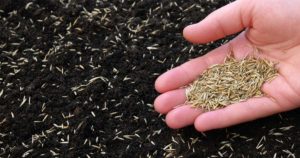
Fertilizing Lawns in the Fall – Because lawns have been actively growing all summer without respite, they are now pretty well out of gas. They need to be fed as they enter the active fall growing season. Lawns should be fertilized twice each and every fall. This first feeding is to green it back up after growing and using everything over the summer. It also gets the lawn ready for whatever upgrading activities (seeding, aerating, liming) you plan for this fall. This feeding is with an organic-based, slow-release nitrogen (16-2-3 Lawn Depot Turf Food), and will subtly feed the old and young grasses for 6-8 weeks. The second fall feeding is in late October through November, and is with Lawn Depot WINTERFEAST. In late fall, once the growth rate has slowed or stopped, the grass roots are still growing actively. This late fall feeding helps build stronger roots, improving winter hardiness and improving spring green up.
Broadleaf Weed Control with Liquid TRIMEC Herbicide – Because we’ve had regular rainfall throughout the summer, we’ve all got lots of weeds in our lawns at this time. Remove them now, at the end of their growing seasons, with an application (whole lawn if you’ve got lots of weeds, spot treatment if you only see a few upon close examination of the whole lawn). By killing all perennial weeds at the end of their respective growing season, you’re eliminating next spring’s weed pests: dandelions, plantain, clover, and many more. And if you’re planning on seeding this fall, apply your TRIMEC herbicide first, wait 2 weeks, and then seed. Remember to apply TRIMEC when no rain is in the forecast for at least 12 hours and allow 24 hours before mowing the lawn.
Seeding in the Late Summer/Early Fall – It is my very strong opinion (and many others in the turf business) that everyone who cares about his/her lawn, and wants a nice lawn should do at least SOME SEEDING EVERY FALL. Summer heat, insect and/or weed encroachment, and turf disease all tend to thin out healthy lawns over the summer. Fertilizing helps to thicken damaged turf to some extent, but for most of us, overseeding is still the best way to get our lawns thick and lush again going into the winter and next spring. The Lawn Depot sells several mixes and blends of all the top-rated cool season turfgrasses directly from the west coast growers. We offer both quantity discounts as well as loyalty program discounts. And if you are a Turf Management customer you are entitled to 20% off everything that our store offers!
Grub Control in the Early Fall-Grubs (the larval stage of the Japanese beetle and many other beetles) can be a serious problem in the early fall in that they hatch in the shallow soil among grass roots, feed exclusively on those roots, and in sufficient concentrations can devastate lush and healthy lawns. The main problem is that you can’t see them feeding until the turf begins to die and damaged turf can be easily scratched up by hand or with a rake. By then it’s too late and the entire lawn/area must be stripped and reseeded, which cannot be easily done in time for complete recovery this fall. Fortunately, most of you have applied granular preventative grub control (MERIT, MALLET) in May, June or early July and won’t have to worry about grubs through the entire growing season. If you didn’t apply Merit/Mallet this spring, had a fair number of Japanese beetles in July, and have the off-color turf that peels back easily now revealing the grubs, you have to apply DYLOX 24-hour grub control and water in thoroughly over the entire lawn or area, and then reseed. Then next spring, apply preventative grub control.
Crabgrass, Japanese Stiltgrass, and Yellow Nutsedge – Crabgrass and Japanese Stiltgrass are both annual grassy weeds (they have already set their seeds for next year; their growth will slow precipitously as the nights cool). They are most easily and most effectively controlled by applying PRE-EMERGENT control products (DIMENSION) in the early spring. Yellow nutsedge is a perennial sedge (reed) that only grows actively in warm weather, particularly in wet areas of lawns. Nutsedge has already formed its nuts at the terminals of its roots, so treating it or pulling it in September will not accomplish much. Nutsedge should be treated from the time it first starts appearing in lawns and beds with a nutsedge-specific herbicide (sold at the Lawn Depot). Re-apply as new shoots appear through mid-August for best results.
Liming and/or Core Aerating in the Fall – Lime sweetens our naturally acidic soils, which allows fertilizers to work better and thus, grass to thrive. Core aeration (not spiking, pulling plugs from the softened soil) opens up our dense soils, and allows moisture (irrigation, rainfall) to enter deeper into the turf’s root zones, thus allowing your lawns to have deeper, denser root systems and be better able to fight off the effects of stressful weather, insects and diseases. Liming should be done every year, at the maintenance rate. If you haven’t limed for several years, apply at the heavy rate. Use either pelletized lime or fast acting lime to get sweeter soil more quickly. Core aeration can be done spring or fall (or both), whenever the soil is soft enough to pull at least 2-3” plugs.
